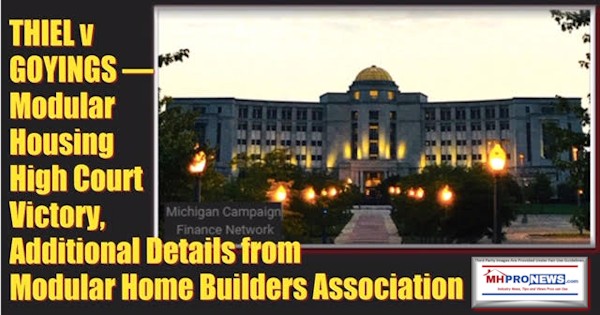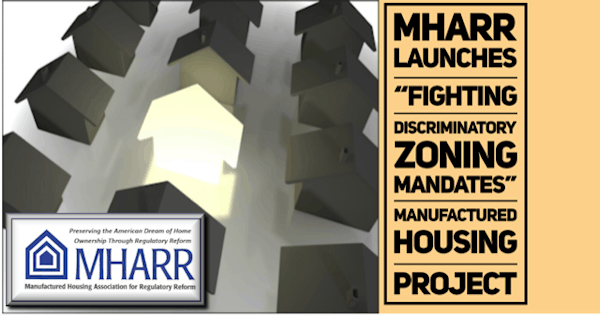
In case you missed it (ICYMI), last week there was a significant legal victory that the Modular Home Builders (MHBA) was pleased to have participated in.
That original report is linked here and below. It is necessary to grasp the added details that follow.
In a follow up to obtain the legal syllabus of the case, a source that claimed knowledge with the MHBA told MHProNews that, “We [the modular builders trade association] were approached by the manufacturer first to get involved. Then we talked with the builder. Both agreed it would be helpful for MHBA to weigh in. Our board concurred and we hired a local attorney to assist. We didn’t even speak with the homeowner until this week [past] when the case was finally resolved. It was a rather lengthy process but obviously we are happy that the home owners did not have to tear down their new home. And the homeowner was more than happy that we supported them through this ordeal. I think this does provide an opportunity for the industry to reach out to developers and help them craft more meaningful covenants to protect their investments without impeding on consumer choices.”
A video of the oral arguments published on March 28, 2019 is posted below.
The syllabus provided by the MHBA to MHProNews begins as follows.
THIEL v GOYINGS Docket No. 156708.
Argued on application for leave to appeal March 6, 2019. Decided July 24, 2019. Matthew T. Thiel and Nikole M. Thiel brought an action in the Allegan Circuit Court against David L. Goyings and Helen M. Goyings, requesting that the court enjoin the Goyingses’ construction of a home in the Timber Ridge Bay subdivision of Watson Township and order that the modular components of the home be removed or destroyed because the home violated the subdivision’s restrictive covenants prohibiting the construction of modular homes. About a month after the suit was filed, William and Marcia Traywick joined as intervening plaintiffs. The Goyingses had selected Heritage Custom Builders, Cassidy Builders, Inc., and Ritz-Craft Corporation of Michigan, Inc., to design and build their home. Those builders specialized in systems-built homes constructed using a hybrid method of homebuilding that integrated modular components into on-site, stick-built construction. Through this method, part of the Goyingses’ home was stick-built on-site, and three modular components were built off-site and delivered to the lot. In total, the completed home was to be composed of about 59% stick-built construction and 41% modular components. When the Goyingses’ neighbors noticed delivery of modular components to the lot, Matthew Thiel and William Traywick contacted the Goyingses to inform them that installation of the modular home would violate the restrictive covenants and that they would take legal action. The Goyingses continued with the home’s construction, and the modules were attached to a foundation of the same square footage as the assembled modules. The Thiels brought the instant lawsuit and moved for summary disposition, which the trial court denied. The case proceeded to a three-day bench trial, at which the court heard testimony from the parties and from a township building official, an appraiser, and the Goyingses’ builder. The court, Margaret Zuzich Bakker, J., held that the restrictive covenants did not contemplate the type of hybrid home that the Goyingses had built and that the home was “sufficiently constructed, valued, and congenial as to allow it to remain.” Plaintiffs appealed. In an unpublished per curiam opinion issued on August 8, 2017 (Docket No. 333000), the Court of Appeals, HOEKSTRA, P.J., and MURPHY and K. F. KELLY, JJ., reversed, holding that the restrictive covenants were unambiguous and that the Goyingses’ home was in clear violation of those covenants. The Goyingses sought leave to appeal in the Supreme Court, and the Supreme Court ordered and heard oral argument on whether to grant the application or take other action. 501 Mich 1030 (2018). Michigan Supreme Court Lansing, Michigan Syllabus Chief Justice: Bridget M. McCormack Chief Justice Pro Tem: David F. Viviano Justices: Stephen J. Markman Brian K. Zahra Richard H. Bernstein Elizabeth T. Clement Megan K. Cavanagh This syllabus constitutes no part of the opinion of the Court but has been prepared by the Reporter of Decisions for the convenience of the reader. Reporter of Decisions: Kathryn L. Loomis
In an opinion by Chief Justice MCCORMACK, joined by Justices VIVIANO, BERNSTEIN, CLEMENT, and CAVANAGH, the Supreme Court, in lieu of granting leave to appeal, held:
Courts review restrictive covenants with a special focus on determining the restrictor’s intent. Unambiguous restrictions must be enforced as written, but any uncertainty or doubt must be resolved in favor of the free use of property. In this case, the dispute was not about the definition of the word “modular”; rather, the dispute concerned how the subdivision’s restrictive covenants defined a “modular home.” The restrictive covenants stated, “All residences shall be stick built on site and no . . . modular home . . . will be erected on any of the Parcels unless provided for herein.” A fair reading of a modifier like “modular” applies its meaning to the noun as a whole. The limiting factor is the extent to which the noun accepts the modifier. A homogenous or abstract thing often accepts the modifier wholly (a blue circle, a truthful statement); most things that exist in the real world have some degree of heterogeneity and fully accept modifiers within the bounds of reason (a red car, a friendly neighbor). And houses, like cars or people, are not just one thing. Accordingly, the most natural reading of the phrase “modular home” is a home that is mostly or generally modular. That is, a home is a modular home under the restrictive covenants if it is predominantly modular—more modular than not. If the phrase “pre-fabricated or modular home” were interpreted to include any home constructed using a modular or prefabricated component, that interpretation would render the covenant provision unenforceable because every home doubtless contains some prefabricated part. Additionally, reading the phrase “modular home” in the context of the other terms revealed that a modular home is of a kind with prefabricated homes, geodesic domes, berm-houses, mobile homes, shacks, and barns. The covenants’ use of different terms also suggested an important difference between a permissible home and a prohibited one in how it comes to be built. The covenants’ use of verbs like “move,” “place,” or “locate” suggested picking up something that already exists and plunking it down on the lot, fully formed. And a difference exists between structures that are constructed versus erected: to construct a structure evokes forming or creating that structure by putting together its parts, whereas to erect a structure connotes assembling or raising it. In this case, the Goyingses’ home was not a relocated residence because each modular component was merely a raw piece of construction material delivered to the lot, and the Goyingses’ home was also not a manufactured housing unit because the common understanding of that term is a mobile home. The materials, workmanship, quality, and outward appearance of the Goyingses’ home were indistinguishable from a site-built home. The language of the restrictive covenants supported the trial court’s finding that there is a distinction between a modular or prefabricated home and a site-built home with modular or prefabricated components. Therefore, applying the covenants to the undisputed facts found by the trial court, the Goyingses’ home was not a “pre-fabricated or modular home” as the restrictive covenants use that phrase because the Goyingses’ home was mainly stick-built with modular components integrated into it. The Court of Appeals erred when it implicitly held that the restrictive covenants prohibited any home that contained a module.
Court of Appeals opinion reversed; trial court decision reinstated.
The balance of the 30 page THIEL v GOYINGS syllabus is linked here as a download.
The prior case as initially reviewed by MHProNews, once more is linked here for readers ease of access. This useful outcome merits both applause for the modular housing association’s engagement, while begging the question, why hasn’t the Manufactured Housing Institute done similarly?
Sounding Off! Going “On the Record” – Manufactured Housing Controversies, Opportunities
That’s the first look today at “News through the lens of manufactured homes and factory-built housing,” © where “We Provide, You Decide.” © ## (News, analysis, and commentary.)

Soheyla is a managing member of LifeStyle Factory Homes, LLC, the parent company to MHProNews, and MHLivingNews.com. Connect with us on LinkedIn here and here.
Related Reports:
Click the image/text box below to access relevant, related information.
MHARR Meeting with New FHFA Leadership
JULY 15, 2019 TO: MHARR MANUFACTURERS MHARR TECHNICAL REVIEW GROUP (TRG) MHARR STATE AFFILIATES FROM: MHARR RE: MHARR MEETING WITH NEW FHFA LEADERSHIP An MHARR delegation met with senior officials of the Federal Housing Finance Agency (FHFA) on July 11, 2019, including newly-confirmed FHFA Director, Dr. Mark Calabria.


























